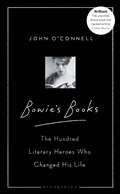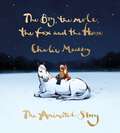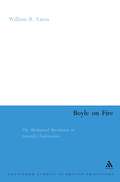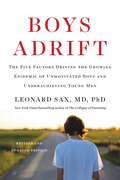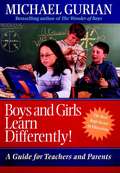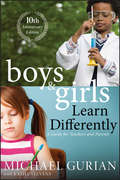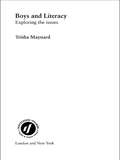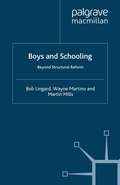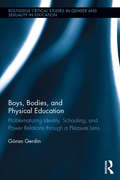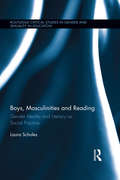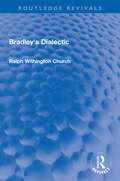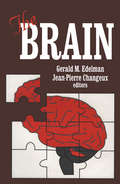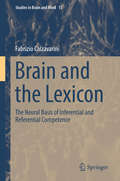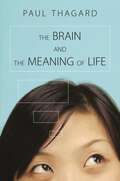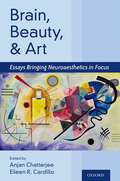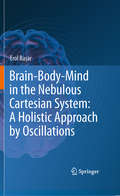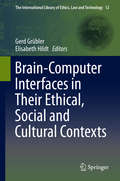- Table View
- List View
Bowie's Books: The Hundred Literary Heroes Who Changed His Life
by John O'ConnellA TIMES BOOK OF THE YEAR'Brilliant. The unwritten Bowie book that needed writing' CAITLIN MORAN'Splendid. Provides plenty of evidence of Bowie's restless, rummaging intelligence, and his pleasure in the fact that books allow readers to slip into someone else's skin and try it on for size' THE TIMES'A witty and enlightening analysis of Bowie's 100 essential books . . . A handy, amusing, light-touch precis' OBSERVER'What is your idea of perfect happiness?' 'Reading.''What is the quality you most like in a man?''The ability to return books.'Three years before he died, David Bowie made a list of the one hundred books that had transformed his life – a list that formed something akin to an autobiography. From Madame Bovary to A Clockwork Orange, the Iliad to the Beano, these were the publications that had fuelled his creativity and shaped who he was. In Bowie's Books, John O'Connell explores this list in the form of one hundred short essays, each offering a perspective on the man, performer and creator that is Bowie, his work as an artist and the era that he lived in.Brilliantly illustrated throughout and the perfect gift for Bowie fans and book lovers, Bowie's Books is much more than a list of books you should read in your lifetime: it is a unique insight into one of the greatest minds of our times, and an indispensable part of the legacy that Bowie left behind.
The Boy, the Mole, the Fox and the Horse: The Animated Story
by Charlie MackesyA journey, in search of homeCharlie Mackesy's beloved The Boy, the Mole, the Fox and the Horse has been adapted into an animated short film, coming to BBC One and iPlayer this Christmas.This beautifully made hardback celebrates the work of over 100 animators across two years of production - with Charlie's distinctive illustrations brought to life in full colour with hand-drawn traditional animation and accompanying hand-written script."I made a film with some friends about a boy, a mole, a fox and a horse - their journey together and the boy's search for home. I hope this book gives you courage and makes you feel loved." Love Charlie x
Boyle on Fire: The Mechanical Revolution in Scientific Explanation (Continuum Studies in British Philosophy)
by William EatonThe philosophy of Robert Boyle (1627-1691) is a hot topic in early modern philosophy. Boyle was at the centre of the scientific community of 17th-century England, and an accurate view of the Enlightenment scientific revolution is impossible without recognition of the contributions that he made. Work on Boyle's philosophy is also shedding light on contemporary issues in the philosophy of science - it can help us understand the nature of scientific explanation and the role that the mechanical model of explanation plays in present-day science. Boyle's mechanical philosophy ushered in a new explanatory model for science and even though his corpuscular hypothesis failed, its failure does not entail the failure of the explanatory model of which it was an instance. Boyle on Fire demonstrates these points by examining Boyle's work concerning a method of experiment common in the seventeenth century called Fire Analysis. In the Sceptical Chymist (1661), Boyle attacks elemental theories of chemical explanation primarily by raising objections against Aristotelian and Paracelsian interpretations of fire analysis. The book reconstructs Boyle's corpuscular account of fire analysis and then compares it to these objections. This process reveals those characteristics of mechanical explanations that make them epistemologically superior to elemental theories of chemical explanation, and it is these characteristics that survive the death of the corpuscular hypothesis and have become an enduring feature of the scientific enterprise.
Boys Adrift: The Five Factors Driving the Growing Epidemic of Unmotivated Boys and Underachieving Young Men
by Leonard SaxWhy America's sons are underachieving, and what we can do about it.Something is happening to boys today. From kindergarten to college, American boys are, on average, less resilient and less ambitious than they were a mere twenty years ago. The gender gap in college attendance and graduation rates has widened dramatically. While Emily is working hard at school and getting A's, her brother Justin is goofing off. He's more concerned about getting to the next level in his videogame than about finishing his homework.In Boys Adrift, Dr. Leonard Sax delves into the scientific literature and draws on more than twenty years of clinical experience to explain why boys and young men are failing in school and disengaged at home. He shows how social, cultural, and biological factors have created an environment that is literally toxic to boys. He also presents practical solutions, sharing strategies which educators have found effective in re-engaging these boys at school, as well as handy tips for parents about everything from homework, to videogames, to medication.
Boys and Girls Learn Differently!: A Guide for Teachers and Parents
by Michael Gurian Philip CarterAt last, we have the scientific evidence that documents the manybiological gender differences that influence learning. Forinstance, girls talk sooner, develop better vocabularies, readbetter, and have better fine motor skills. Boys, on the other hand,have better auditory memory, are better at three-dimensionalreasoning, are more prone to explore, and achieve greater abstractdesign ability after puberty. In this profoundly significant book, author Michael Guriansynthesizes the current knowledge and clearly demonstrates how thisdistinction in hard-wiring and socialized gender differencesaffects how boys and girls learn. Gurian presents a new way toeducate our children based on brain science, neurologicaldevelopment, and chemical and hormonal disparities. The innovationspresented in this book were applied in the classroom and provensuccessful, with dramatic improvements in test scores, during atwo-year study that Gurian and his colleagues conducted in sixMissouri school districts.
Boys and Girls Learn Differently! A Guide for Teachers and Parents: A Guide For Teachers And Parents
by Michael GurianA thoroughly revised edition of the classic resource for understanding gender differences in the classroom In this profoundly significant book, author Michael Gurian has revised and updated his groundbreaking book that clearly demonstrated how the distinction in hard-wiring and socialized gender differences affects how boys and girls learn. Gurian presents a proven method to educate our children based on brain science, neurological development, and chemical and hormonal disparities. The innovations presented in this book were applied in the classroom and proven successful, with dramatic improvements in test scores, during a two-year study that Gurian and his colleagues conducted in six Missouri school districts. Explores the inherent differences between the developmental neuroscience of boys and girls Reveals how the brain learns Explains when same sex classrooms are appropriate, and when they’re not This edition includes new information on a wealth of topics including how to design the ultimate classroom for kids in elementary, secondary, middle, and high school.
Boys and Girls Learn Differently! A Guide for Teachers and Parents: A Guide For Teachers And Parents
by Michael GurianA thoroughly revised edition of the classic resource for understanding gender differences in the classroom In this profoundly significant book, author Michael Gurian has revised and updated his groundbreaking book that clearly demonstrated how the distinction in hard-wiring and socialized gender differences affects how boys and girls learn. Gurian presents a proven method to educate our children based on brain science, neurological development, and chemical and hormonal disparities. The innovations presented in this book were applied in the classroom and proven successful, with dramatic improvements in test scores, during a two-year study that Gurian and his colleagues conducted in six Missouri school districts. Explores the inherent differences between the developmental neuroscience of boys and girls Reveals how the brain learns Explains when same sex classrooms are appropriate, and when they’re not This edition includes new information on a wealth of topics including how to design the ultimate classroom for kids in elementary, secondary, middle, and high school.
Boys and Literacy: Exploring the Issues (Language and Literacy in Action)
by Trisha MaynardIn recent years the issue of boys and literacy, namely that they are worse at it compared to girls, has become a key area of interest to all those concerned with the education of our children. This book highlights the key factors causing this divide and discusses the implementation of new strategies to overcome it, which have been the result of extensive qualitative research made by the author. Trisha Maynard reports case study findings of a primary school whose staff wanted to explore and improve boys' attitudes towards and attainment in literacy, and in particular their difficulties with writing.The book highlights issues concerning the reading and writing of stories, what teachers understand by 'good story writing' and the importance of teachers exploring boys' and girls' difficulties with literacy by themselves. It provides significant insight into boys' difficulties with writing as well as informing teachers how to find out about children's attainment.
Boys and Literacy: Exploring the Issues (Language and Literacy in Action)
by Trisha MaynardIn recent years the issue of boys and literacy, namely that they are worse at it compared to girls, has become a key area of interest to all those concerned with the education of our children. This book highlights the key factors causing this divide and discusses the implementation of new strategies to overcome it, which have been the result of extensive qualitative research made by the author. Trisha Maynard reports case study findings of a primary school whose staff wanted to explore and improve boys' attitudes towards and attainment in literacy, and in particular their difficulties with writing.The book highlights issues concerning the reading and writing of stories, what teachers understand by 'good story writing' and the importance of teachers exploring boys' and girls' difficulties with literacy by themselves. It provides significant insight into boys' difficulties with writing as well as informing teachers how to find out about children's attainment.
Boys and Schooling: Beyond Structural Reform
by B. Lingard W. Martino M. MillsExploring current approaches to addressing boys' education in schools, this book highlights the limitations of structural reform initiatives and the failure to address the impact of socioeconomic status, race, sexuality, disability and hegemonic masculinity on both boys' and girls' participation in schooling.
Boys, Bodies, and Physical Education: Problematizing Identity, Schooling, and Power Relations through a Pleasure Lens (Routledge Critical Studies in Gender and Sexuality in Education)
by Göran GerdinUsing visual ethnography, this book explores the many forms of pleasures that boys derive in and through the spaces and their bodies in physical education. Employing the works of Michel Foucault and Judith Butler, Gerdin examines how pleasure is connected to identity, schooling, and power relations, and demonstrates how discourses of sport, fitness, health and masculinity work together to produce a variety of pleasurable experiences. At the same time, the book provides a critique of such pleasurable experiences within physical education by illustrating how these pleasures can still, for some boys, quickly turn into displeasures and can be associated with exclusion, humiliation, bullying and homophobia. Boys, Bodies, and Physical Education argues that pleasure can both be seen as an educational and productive practice in physical education but also a constraint that both engenders and privileges some boys over others as well as (re)producing narrow and limited conceptions of masculinity and pleasures for all boys. This book works to problematize these pleasures and their articulations with gender, bodies, and spaces.
Boys, Bodies, and Physical Education: Problematizing Identity, Schooling, and Power Relations through a Pleasure Lens (Routledge Critical Studies in Gender and Sexuality in Education)
by Göran GerdinUsing visual ethnography, this book explores the many forms of pleasures that boys derive in and through the spaces and their bodies in physical education. Employing the works of Michel Foucault and Judith Butler, Gerdin examines how pleasure is connected to identity, schooling, and power relations, and demonstrates how discourses of sport, fitness, health and masculinity work together to produce a variety of pleasurable experiences. At the same time, the book provides a critique of such pleasurable experiences within physical education by illustrating how these pleasures can still, for some boys, quickly turn into displeasures and can be associated with exclusion, humiliation, bullying and homophobia. Boys, Bodies, and Physical Education argues that pleasure can both be seen as an educational and productive practice in physical education but also a constraint that both engenders and privileges some boys over others as well as (re)producing narrow and limited conceptions of masculinity and pleasures for all boys. This book works to problematize these pleasures and their articulations with gender, bodies, and spaces.
Boys, Masculinities and Reading: Gender Identity and Literacy as Social Practice (Routledge Critical Studies in Gender and Sexuality in Education)
by Laura ScholesBoys, Masculinities and Reading explores elementary students’ interpretations of their experiences of reading and the contextual influences that impact those experiences. While research continues to highlight the apparent systematic underperformance of boys in comparison to girls on national and international reading benchmarks, this text moves beyond broad generalizations to consider complexities inherent in notions of masculinity and associated tensions. Applying a socio-cultural perspective, Scholes highlights the voices of boys and girls by focusing on their reading experiences. Examining the perceived, generalized "crisis" of boys’ underperformance in reading and literacy, Scholes identifies the factors that shape perceptions of masculinity among different groups of boys across the globe.
Boys, Masculinities and Reading: Gender Identity and Literacy as Social Practice (Routledge Critical Studies in Gender and Sexuality in Education)
by Laura ScholesBoys, Masculinities and Reading explores elementary students’ interpretations of their experiences of reading and the contextual influences that impact those experiences. While research continues to highlight the apparent systematic underperformance of boys in comparison to girls on national and international reading benchmarks, this text moves beyond broad generalizations to consider complexities inherent in notions of masculinity and associated tensions. Applying a socio-cultural perspective, Scholes highlights the voices of boys and girls by focusing on their reading experiences. Examining the perceived, generalized "crisis" of boys’ underperformance in reading and literacy, Scholes identifies the factors that shape perceptions of masculinity among different groups of boys across the globe.
Bradley's Dialectic (Routledge Revivals)
by Ralph W. ChurchFirst published in 1942, Bradley’s Dialectic is a competent survey of Bradley’s leading philosophical principles, together with its difficulties. The primary objective is to bring out in somewhat simple terms the essential character of Bradley’s dialectic. Here ‘dialectic’ means a method of elucidation. Professor Church’s appraisal of the pertinence of Bradley’s dialectic is heightened by his critical discussion of several less elucidated metaphysical features. In this connection, he submits a penetrating criticism of misrepresentations of Bradley’s views, especially in the important subject of Relations and its place in the structure and development of Thought. Although brief, Professor Church’s analysis is a vital study of crucial themes in philosophy, which will appeal to students of Philosophy and Metaphysics.
Bradley's Dialectic (Routledge Revivals)
by Ralph W. ChurchFirst published in 1942, Bradley’s Dialectic is a competent survey of Bradley’s leading philosophical principles, together with its difficulties. The primary objective is to bring out in somewhat simple terms the essential character of Bradley’s dialectic. Here ‘dialectic’ means a method of elucidation. Professor Church’s appraisal of the pertinence of Bradley’s dialectic is heightened by his critical discussion of several less elucidated metaphysical features. In this connection, he submits a penetrating criticism of misrepresentations of Bradley’s views, especially in the important subject of Relations and its place in the structure and development of Thought. Although brief, Professor Church’s analysis is a vital study of crucial themes in philosophy, which will appeal to students of Philosophy and Metaphysics.
The Brain: Cortical Organization And The Group-selective Theory Of Higher Brain Function
by Jean-Pierre Changeux Gerald M. EdelmanOne of the vastly exciting areas in modern science involves the study of the brain. Recent research focuses not only on how the brain works but how it is related to what we normally call the mind, and throws new light on human behavior. Progress has been made in researching all that relates to interior man, why he thinks and feels as he does, what values he chooses to adopt, and what practices to scorn. All of these attributes make us human and help to explain art, philosophy, and religions. Motion, sight, and memory, as well as emotions and the sentiments common to humans, are all given new meaning by what we have learned about the brain. In an introductory essay, Vernon B. Mountcastle traces the progress made in brain science during this century. Gerald M. Edelman touches upon features of the brain that challenge the picture of the brain as a machine. Semir Zeki discusses artists and artistic expression as an extension of the function of the brain. Richard S. J. Frackowiak probes the functional architecture of the brain. Mark F. Bear and Leon N Cooper explore whether complex neural systems can be illuminated by theoretical structures. Jean-Pierre Changeux sheds light on the knowledge gained in recent years concerning the neurobiology and pharmacology of drug action and addiction. Alexander A. Borbuly and Giulio Tononi ponder the quest for the essence of sleep, illuminating its complex dynamic process. George L. Gabor Miklos examines variations in neuroanatomies and sensory systems between individuals of the same species as well as variations across the evolutionary spectrum. Emilio Bizzi and Ferdinando A. Mussa-Ivaldi explain how scientists have approached the study of movement, the problems encountered, and the solutions proposed. Marcel Kinsbourne explores the unity and diversity in the human brain. In the concluding essay, Andy Clark points to recent work in neuroscience, robotics, and psychology that stresses the unexpected intimacy of brain, body, and world, supporting his belief that the mind is best understood as a brain at home in its proper bodily cultural and environmental niche. The breadth and scope of subjects covered in this volume attest to the extraordinary progress taking place in the study of the brain. This brilliant collection of essays by those at the forefront of research in this area will be of interest to all those interested in human behavior. Gerald M. Edelman is director of the Neurosciences Institute and chairman of the Department of Neurobiology at the Scripps Research Institute. Jean-Pierre Changeux is professor at the Collbge de France and the Institute Pasteur.
The Brain
by Jean-Pierre Changeux Gerald M. EdelmanOne of the vastly exciting areas in modern science involves the study of the brain. Recent research focuses not only on how the brain works but how it is related to what we normally call the mind, and throws new light on human behavior. Progress has been made in researching all that relates to interior man, why he thinks and feels as he does, what values he chooses to adopt, and what practices to scorn. All of these attributes make us human and help to explain art, philosophy, and religions. Motion, sight, and memory, as well as emotions and the sentiments common to humans, are all given new meaning by what we have learned about the brain. In an introductory essay, Vernon B. Mountcastle traces the progress made in brain science during this century. Gerald M. Edelman touches upon features of the brain that challenge the picture of the brain as a machine. Semir Zeki discusses artists and artistic expression as an extension of the function of the brain. Richard S. J. Frackowiak probes the functional architecture of the brain. Mark F. Bear and Leon N Cooper explore whether complex neural systems can be illuminated by theoretical structures. Jean-Pierre Changeux sheds light on the knowledge gained in recent years concerning the neurobiology and pharmacology of drug action and addiction. Alexander A. Borbuly and Giulio Tononi ponder the quest for the essence of sleep, illuminating its complex dynamic process. George L. Gabor Miklos examines variations in neuroanatomies and sensory systems between individuals of the same species as well as variations across the evolutionary spectrum. Emilio Bizzi and Ferdinando A. Mussa-Ivaldi explain how scientists have approached the study of movement, the problems encountered, and the solutions proposed. Marcel Kinsbourne explores the unity and diversity in the human brain. In the concluding essay, Andy Clark points to recent work in neuroscience, robotics, and psychology that stresses the unexpected intimacy of brain, body, and world, supporting his belief that the mind is best understood as a brain at home in its proper bodily cultural and environmental niche. The breadth and scope of subjects covered in this volume attest to the extraordinary progress taking place in the study of the brain. This brilliant collection of essays by those at the forefront of research in this area will be of interest to all those interested in human behavior. Gerald M. Edelman is director of the Neurosciences Institute and chairman of the Department of Neurobiology at the Scripps Research Institute. Jean-Pierre Changeux is professor at the Collbge de France and the Institute Pasteur.
Brain and the Lexicon: The Neural Basis of Inferential and Referential Competence (Studies in Brain and Mind #15)
by Fabrizio CalzavariniThis monograph offers a novel, neurocognitive theory concerning words and language. It explores the distinction between inferential and referential semantic competence. The former accounts for the relationship of words among themselves, the latter for the relationship of words to the world. The author discusses this distinction at the level of the human brain on both theoretical and neuroscientific grounds. In addition, this investigation considers the relation between the inf/ref neurocognitive theory and other accounts of semantic cognition proposed in the field of neurosemantics, as well as some potential implications of the theory for clinical neuroscience and the philosophy of semantics. Overall, the book offers an important contribution to the debate about lexical semantic competence. It combines a strong philosophical and linguistic background with a comprehensive and critical analysis of neurosemantic literature. Topics discussed lie at the intersection of philosophical semantics, linguistics, neurolinguistics, cognitive science, artificial intelligence, cognitive neuroscience, and clinical psychology. Due to its interdisciplinary orientation, coverage is rich in introductory remarks and not overly technical, therefore it is accessible to non-experts as well.
The Brain and the Meaning of Life
by Paul ThagardWhy is life worth living? What makes actions right or wrong? What is reality and how do we know it? The Brain and the Meaning of Life draws on research in philosophy, psychology, and neuroscience to answer some of the most pressing questions about life's nature and value. Paul Thagard argues that evidence requires the abandonment of many traditional ideas about the soul, free will, and immortality, and shows how brain science matters for fundamental issues about reality, morality, and the meaning of life. The ongoing Brain Revolution reveals how love, work, and play provide good reasons for living. Defending the superiority of evidence-based reasoning over religious faith and philosophical thought experiments, Thagard argues that minds are brains and that reality is what science can discover. Brains come to know reality through a combination of perception and reasoning. Just as important, our brains evaluate aspects of reality through emotions that can produce both good and bad decisions. Our cognitive and emotional abilities allow us to understand reality, decide effectively, act morally, and pursue the vital needs of love, work, and play. Wisdom consists of knowing what matters, why it matters, and how to achieve it. The Brain and the Meaning of Life shows how brain science helps to answer questions about the nature of mind and reality, while alleviating anxiety about the difficulty of life in a vast universe. The book integrates decades of multidisciplinary research, but its clear explanations and humor make it accessible to the general reader.
The Brain and the Meaning of Life
by Paul ThagardWhy is life worth living? What makes actions right or wrong? What is reality and how do we know it? The Brain and the Meaning of Life draws on research in philosophy, psychology, and neuroscience to answer some of the most pressing questions about life's nature and value. Paul Thagard argues that evidence requires the abandonment of many traditional ideas about the soul, free will, and immortality, and shows how brain science matters for fundamental issues about reality, morality, and the meaning of life. The ongoing Brain Revolution reveals how love, work, and play provide good reasons for living. Defending the superiority of evidence-based reasoning over religious faith and philosophical thought experiments, Thagard argues that minds are brains and that reality is what science can discover. Brains come to know reality through a combination of perception and reasoning. Just as important, our brains evaluate aspects of reality through emotions that can produce both good and bad decisions. Our cognitive and emotional abilities allow us to understand reality, decide effectively, act morally, and pursue the vital needs of love, work, and play. Wisdom consists of knowing what matters, why it matters, and how to achieve it. The Brain and the Meaning of Life shows how brain science helps to answer questions about the nature of mind and reality, while alleviating anxiety about the difficulty of life in a vast universe. The book integrates decades of multidisciplinary research, but its clear explanations and humor make it accessible to the general reader.
Brain, Beauty, and Art: Essays Bringing Neuroaesthetics into Focus
by Anjan Chatterjee and Eileen R. CardilloAesthetics has long been the preserve of philosophy, art history, and the creative arts but, more recently, the fields of psychology and neuroscience have entered the discussion, and the field of neuroaesthetics has been born. In Brain, Beauty, and Art, leading scholars in this nascent field reflect on the promise of neuroaesthetics to enrich our understanding of this universal yet diverse facet of human experience. The volume consists of essays from foundational researchers whose empirical work launched the field. Each essay is anchored to an original, peer-reviewed paper from the short history of this new and burgeoning subdiscipline of cognitive neuroscience. Authors of each essay were asked three questions: 1) What motivated the original paper? 2) What were the main findings or theoretical claims made? and, 3) How do those findings or claims fit with the current state and anticipated near future of neuroaesthetics? Together, these essays establish the territory and current boundaries of neuroaesthetics and identify its most promising future directions. Topics include models of neuroaesthetics, and discussions of beauty, art, dance, music, literature, and architecture. Brain, Beauty, and Art will inform and stimulate anyone with an abiding interest in why it is that, across time and culture, we respond to beauty, engage with art, and are affected by music and architecture.
Brain, Beauty, and Art: Essays Bringing Neuroaesthetics into Focus
Aesthetics has long been the preserve of philosophy, art history, and the creative arts but, more recently, the fields of psychology and neuroscience have entered the discussion, and the field of neuroaesthetics has been born. In Brain, Beauty, and Art, leading scholars in this nascent field reflect on the promise of neuroaesthetics to enrich our understanding of this universal yet diverse facet of human experience. The volume consists of essays from foundational researchers whose empirical work launched the field. Each essay is anchored to an original, peer-reviewed paper from the short history of this new and burgeoning subdiscipline of cognitive neuroscience. Authors of each essay were asked three questions: 1) What motivated the original paper? 2) What were the main findings or theoretical claims made? and, 3) How do those findings or claims fit with the current state and anticipated near future of neuroaesthetics? Together, these essays establish the territory and current boundaries of neuroaesthetics and identify its most promising future directions. Topics include models of neuroaesthetics, and discussions of beauty, art, dance, music, literature, and architecture. Brain, Beauty, and Art will inform and stimulate anyone with an abiding interest in why it is that, across time and culture, we respond to beauty, engage with art, and are affected by music and architecture.
Brain-Body-Mind in the Nebulous Cartesian System: A Holistic Approach by Oscillations
by Erol BaşarBrain-Body-Mind in the Nebulous Cartesian System: A Holistic Approach by Oscillations is a research monograph, with didactical features, on the mechanisms of the mind, encompassing a wide spectrum of results and analyses. The book should appeal to scientists and graduate students in the fields of neuroscience, neurology, psychiatry, physiology, psychology, physics and philosophy. Its goals are the development of an empirical-analytical construct, denoted as “Reasonings to Approach the Mind”, and the comprehension of 20 principles for understanding the mind. This book amalgamates results from work on the brain, vegetative system, brains in the evolution of species, the maturing brain, dynamic memory, emotional processes, and cognitive impairment in neuro-psychiatric disorders (Alzheimer, Schizophrenia, Bipolar disorders). The findings are comparatively evaluated within the framework of brain oscillations and neurotransmitters. Further, a holistic approach links the brain to the cardiovascular system and overall myogenic coordination of the vegetative system. The results emphasize that EEG oscillations, ultraslow oscillations, and neurotransmitters are quasi-invariant building blocks in brain-body-mind function and also during the evolution of species: The temporal domain is where the importance of research on neural oscillators is indispensable. The core, holistic concept that emerges is that the brain, spinal cord, overall myogenic system, brain-body-oscillations, and neurotransmitters form a functional syncytium. Accordingly, the concept of “Syncytium Brain-Body-Mind” replaces the concept of “Mind”. P>
Brain-Computer-Interfaces in their ethical, social and cultural contexts (The International Library of Ethics, Law and Technology #12)
by Gerd Grübler Elisabeth HildtThis volume summarizes the ethical, social and cultural contexts of interfacing brains and computers. It is intended for the interdisciplinary community of BCI stakeholders. Insofar, engineers, neuroscientists, psychologists, physicians, care-givers and also users and their relatives are concerned. For about the last twenty years brain-computer-interfaces (BCIs) have been investigated with increasing intensity and have in principle shown their potential to be useful tools in diagnostics, rehabilitation and assistive technology. The central promise of BCI technology is enabling severely impaired people in mobility, grasping, communication, and entertainment. Successful applications are for instance communication devices enabling locked-in patients in staying in contact with their environment, or prostheses enabling paralysed people in reaching and grasping. In addition to this, it serves as an introduction to the whole field of BCI for any interested reader.
